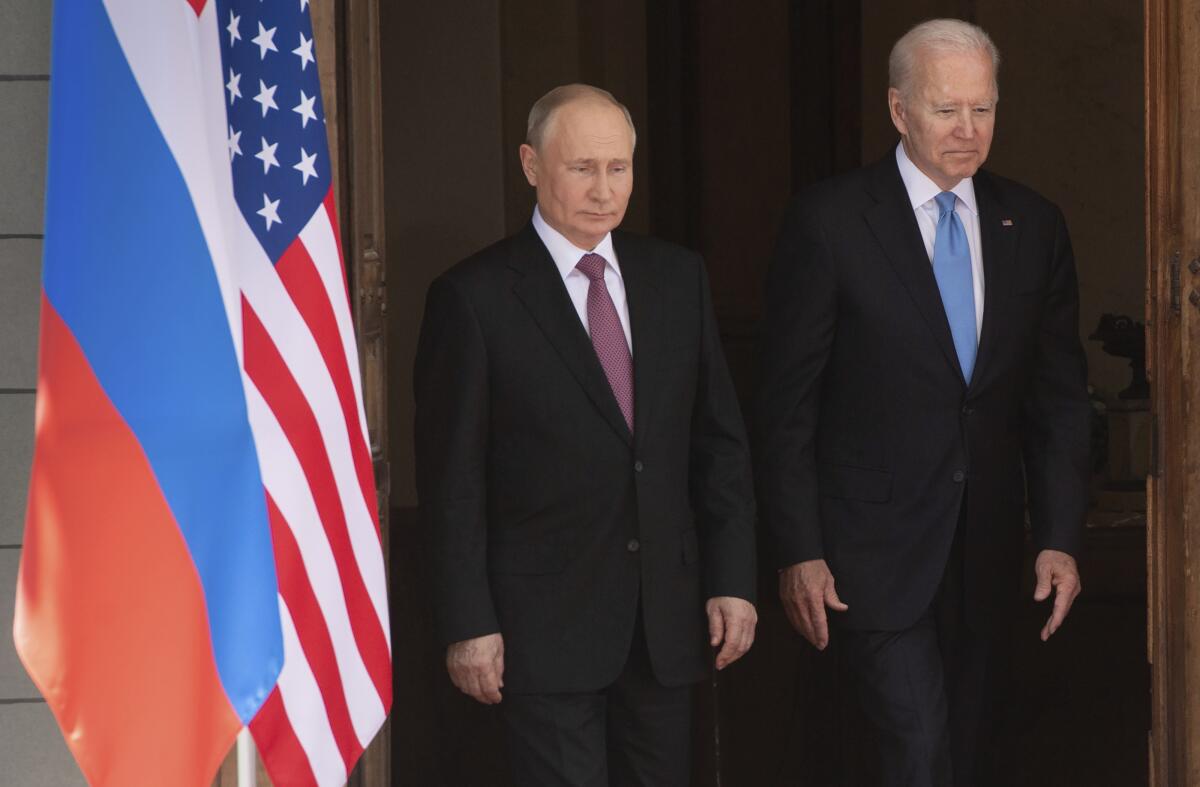Russia feels threatened by NATO. There’s history behind that

- Share via
WASHINGTON — Thirty years ago this month, the Soviet Union collapsed, and Ukraine broke away from Moscow’s control.
Russian President Vladimir Putin has never gotten over it.
Although most Latino voters cast ballots for Democrats, as a group their partisan loyalties are less fixed and less predictable than many other Americans. At least for now, Latinos form the essential swing group in U.S. politics.
That, more than anything, underlies the current crisis in which Putin has moved nearly 100,000 troops to Ukraine’s frontier, raising fears of an invasion.
“To us, the end of the Soviet Union is a done deal,” but not to Putin, said historian Mary Sarotte. “What he really wants to do is renegotiate the 1990s.”
Last week, Russia sent the United States a list of its demands for defusing the crisis: a binding promise that Ukraine will never become a member of the North Atlantic Treaty Organization, plus the removal of all NATO troops and weapons from 14 Eastern European countries that have joined the alliance since 1997.
It was not an encouraging sign. The demands were so extreme that they appeared intended for rejection — or, worse, as a pretext for invasion.
None of this should come as a surprise.
Putin has raged against NATO’s steady expansion toward Russia’s borders for more than a decade. He appears to have decided that the alliance’s deepening relationship with Ukraine, which is not a NATO member, is the last straw.
He’s not wrong about how the alliance’s growth has affected Russia’s perception of its security. Thirty years ago, Russia had a buffer zone of satellite states to its west. Now it has only the unimpressive presence of Belarus.
Russia’s western border is NATO’s eastern flank. American and British military advisors serve in Ukraine; U.S. missile defense systems sit in Poland and Romania; and NATO troops conduct exercises in Estonia, Latvia and Lithuania, once part of the Soviet Union.
Western officials, including the leaders of those “new NATO” countries, view all those measures as purely defensive. Putin, they note, is not the kind of leader who makes neighbors comfortable.
“There is no threat to Russia here,” Fiona Hill, who served on the National Security Council staff under President Trump, told me.
“We are not a threat. Ukraine is most definitely not a threat. … But Putin considers the regathering of Russian lands” — including, in his view, Ukraine — “to be part of his legacy.”
There’s no obvious way to reconcile those opposing viewpoints. This is a problem that can’t be solved — only managed.
President Biden, thrown into the role of crisis manager, is trying a two-track approach: threats of “devastating” sanctions if Russia invades plus an offer to talk about Putin’s overall security concerns.
His position is weakened by the fact that neither the United States nor any of its allies are willing to go to war with Russia over Ukraine.
But it has been strengthened by a remarkable show of allied unity in support of future sanctions, including willingness from Germany to block completion of the Nord Stream 2 pipeline, which is being built to sell more Russian natural gas to Europe.
One of the ironies of Putin’s belligerent approach is that far from weakening NATO, it has driven the 30 countries in the alliance closer together.
The U.S. position contains an irony too: NATO doesn’t really want Ukraine as a member, but it doesn’t want to give Putin veto power over who gets to apply. Allowing Russia to dictate limits to NATO defenses in member countries is even less palatable.
Still, not all of Russia’s arguments are unreasonable.
“There are some concerns on the Russian side that are legitimate,” Steven Pifer, a former U.S. ambassador to Ukraine, told me.
“Putin has complained about American offensive missiles on his border that could reach Moscow in five minutes. There are no such missiles there now, but we could certainly have a conversation about missiles.”
“We could talk about conventional forces too,” Pifer added. “But the conversation would have to cover both sides. It’s not clear that the Russians would get what they want.”
U.S. leaders have known since the Soviet collapse that Russia’s loss of empire would be traumatic. They may not have foreseen that the trauma would persist for 30 years.
“Empires die a slow and painful death,” Sarotte said.
In her suddenly relevant history of NATO’s expansion, “Not One Inch,” she recounts how Presidents George H.W. Bush and Bill Clinton both tried to make a place for Russia in European security institutions and even offered Moscow several forms of affiliation with NATO. But those efforts were overwhelmed by the zeal of former Soviet satellites to become full members of the alliance, beginning with Poland, Hungary and the Czech Republic in 1997, the date Putin cited last week as the point when (in his view) NATO became too big.
Predictably, Republican hawks have reflexively criticized Biden as insufficiently tough on Putin. Sen. Marco Rubio of Florida even charged the president with taking a “path of appeasement.”
But some of Russia’s security concerns are real. Offering to discuss them doesn’t qualify as appeasement. And the stakes are high: A Russian invasion of Ukraine could touch off the worst conflict in Europe since World War II.
Biden and his aides appear to be pursuing careful, hard-headed diplomacy. It may not succeed, but it’s worth a try.
More to Read
Get the L.A. Times Politics newsletter
Deeply reported insights into legislation, politics and policy from Sacramento, Washington and beyond. In your inbox three times per week.
You may occasionally receive promotional content from the Los Angeles Times.












